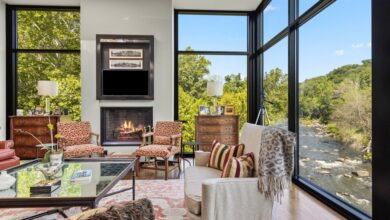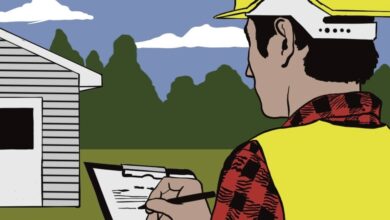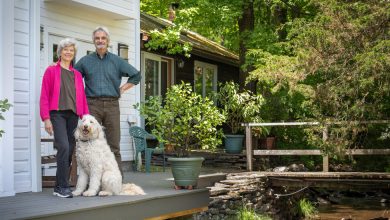In London, a Tucked-Away House Where the Living Is Easy

[ad_1]
This article is part of our latest Design special report, about homes for multiple generations and new definitions of family.
LONDON — The only hint that something special might be hidden behind an unobtrusive house, built in the faux rustic style typical of early-20th-century English suburbs on Haycroft Gardens, a quiet residential street in the Kensal Green area of north London, is the smart smoked larch wood on a door that looks as if it belongs to a garage.
Instead, it opens onto the plot of land where Christine Magid, 76, shares a home with her son, Ben, 40; his partner, Tereza Burgess, 31; and their 5-year-old, Ray. Surrounded by lovely old trees in a terraced garden that cannot be seen from the street, the house was designed by Sarah Wigglesworth Architects as a place where three generations of the family could enjoy the benefits of living together without forfeiting their privacy, while ensuring that Mrs. Magid who, after a lengthy illness, sometimes has difficulty walking, feels safe and comfortable.
“The house is such a long way from the road that it is very, very peaceful, and so thoughtfully designed that there are no steps, no stairs, and I can always look out onto the garden,” Mrs. Magid said. “I lived here on my own for the first six weeks, and that was lovely, but then they all moved in, and that was lovely, too.”
Empty plots are scarce in London’s congested suburbs, and the Magids found theirs by chance. Having sold the family home after Ben moved out, Mrs. Magid rented an apartment from a friend in the unobtrusive house on Haycroft Gardens, intending to stay for a short time while she looked for a permanent place.
Six years later, she had not found one, but had become intrigued by the beautiful trees on a ramshackle plot beside the house (and behind a “garage door”) that was blighted by overgrown brambles and nettles and the debris of a derelict judo studio. When the site came up for sale in 2015, the Magids bought it and commissioned Ms. Wigglesworth to design a house there.
“By then, Mum’s health was quite bad, and stairs were becoming a problem, so the primary concern was for her to have a home where she could be on one level and that could accommodate all of us if we needed to move in with her,” her son said. “But we also wanted to create somewhere that would be beautiful for Mum, and that we’d all love living in together.”
They also needed the house to accommodate caregivers comfortably, should Mrs. Magid need them. Tereza, Ben and Ray divide their time between England and Tereza’s homeland, New Zealand, making it important that someone else could stay in the house to look after Mrs. Magid while they were away.
Having approached several architects, they chose Ms. Wigglesworth, who shared their ecological objectives for the house and who had recently completed a three-year research project into how homes and neighborhoods could be designed to enable different generations to live together.
“One conclusion was that intergenerational living is a good way of providing mutual support and care in an informal way within families,” Ms. Wigglesworth said. “So when Ben presented the project to us, we all thought, ‘Wow!’”
The Magids had hoped to build a bigger house, but were stymied by the local planners’ insistence that it should not seem obtrusive to the rest of the neighborhood and by conservation restrictions that prohibited building near the trees and their roots.
The outcome, the subject of a March article in The Telegraph, was an L-shaped building with an entrance in the middle that opens onto the shared spaces of the kitchen, dining and living areas in one wing, and to the personal spaces of bedrooms and bathrooms in the other.
Mrs. Magid’s bedroom and bathroom are at the end of that wing, allowing for greater privacy. All the main rooms look onto the garden, as do discreet nooks, such as a window seat where someone can sit or read.
The doorways were designed to be wide enough so Mrs. Magid could navigate them in a wheelchair or while using a walker. Building the house and the thresholds into the garden on the same level saves her and Ray from having to negotiate steps while moving around.
The interior surfaces are made from robust materials, including oak for the bedroom floors and a plant-based resin for the living wing floor, in case one of them falls or spills something. “They’re also a little bit softer and warmer for Mum to walk on than concrete,” Ben said.
The site is on a slope that had to be preserved to protect the trees, so benches have been installed to give Mrs. Magid different views of the garden. The main flower bed is positioned near the house to allow her to water plants and deadhead roses with ease. The rest of the garden is designed to create areas where Ray can play on different levels. His bedroom has a door leading out into the garden, where there is a lawn for picnics and games and trails of steppingstones to guide him around the site.
“Everything was designed to be child-friendly and fun for Ray as well as being safe for Christine,” Ms. Wigglesworth said. “We made it easy to see people in different parts of the house and garden so they can all look out for one another.”
Constructing the house from scratch enabled it to be designed in accordance with the energy-efficient principles of the Passive House Institute in Germany. The cedar-clad main structure is made from prefabricated timber cassettes to minimize heat loss, and the building is oriented toward the south and southwest to make the most of the warmth and light of sunshine (a precious commodity in London).
To minimize energy usage, the house is heated by an air-source heat pump and its ventilation is powered by a mechanical-ventilation-with-heat-recovery system.
Having lived in the house with Mrs. Magid after its completion, Ben, Tereza and Ray left England six months later to travel to Thailand and Cambodia, and then to New Zealand to visit Tereza’s family. They were there when the pandemic struck and had to stay because of the country’s strict travel restrictions, although Ben managed to return to London for a visit last summer.
Tereza has a job as an IT consultant, and Ray has started school in New Zealand, while Ben plans to alternate between restoring properties there and visiting his mother in England, where a caregiver visits her regularly.
“If something happened to Mum, I’d go back straightaway,” he said. “But spending time with her in the house has taken away a lot of stress and worry. I know that she’s in as good a place as she can be.”
[ad_2]
Source link






